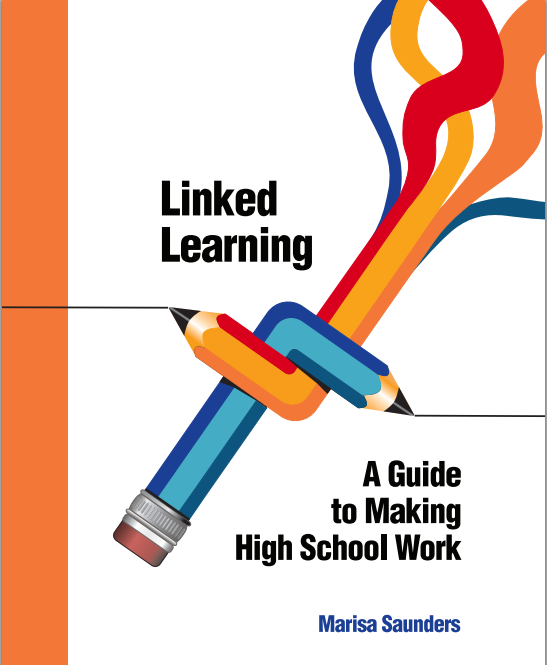College and Career Pathways Leadership Guide
Introduction
Strong leadership is critical to successful transformation of educational practices. As Linked Learning career pathways expand, it becomes ever more important to develop and support leadership. This guide is intended to provide site and district leaders the tools and resources to re-envision and reconstruct leadership in comprehensive high schools where career pathway development is a priority.
CCASN created this guide to leadership development in collaboration with ConnectEd and many career academy and Linked Learning leaders in the field so that district, site and pathway leaders would have the tools and resources to advocate for and train leaders for their crucial role in transforming secondary education.
This online guide provides:
- Historical context for the increasing importance of leadership development to Linked Learning career pathways
- Guidance for developing pathway leadership in four critical areas:
- as system leaders
- as site leaders
- as team leaders
- as key connectors to industry & community partners
- Resources, links and tools embedded throughout
TERMINOLOGY |
In this document, we will use “Linked Learning Pathways” and “College & Career Academies” interchangeably, as there are many ways to refer to this reform design. Other terms used widely include “Multiple Pathways” and “Career Academies.” The common elements that all incorporate include:
|
In California, where California Partnership Academies (CPAs) have been developing effective model practices since the late 1980s, research has consistently demonstrated their impact on student motivation, high school performance and post-secondary earnings. In 2008 the legislature supported the expansion of CPAs to nearly 500, and mandated a release period for lead teachers. The CDE next developed Mentor Academies, then Lighthouse Academies to promote best practices. In 2009, the James Irvine Foundation provided major funding for a District Initiative to begin the process of scaling up, calling this the “Linked Learning” approach. With Irvine Foundation support, ConnectEd began developing a coaching model to work with teacher leaders on pathway development, as well as with district leaders on changing systems to support pathways. Linked Learning picked up steam as the approach moved from small schools and the margins of comprehensive high schools into a systemic reform.
Where robust, high quality programs are implemented, such as in California Partnership Academies (CPAs) and certified Linked Learning pathways, research continues to show substantial success in improving student outcomes (SRI Int. 2). The state legislature therefore approved further investment in this approach, including two $250 million California Career Pathways Trust allocations released in 2014 and 2015. With legislative support, K12 and college districts across the state began working with Workforce Investment Boards, industry partners, and community-based organizations to develop new systems to support this very different way of organizing schools. While striving to implement Common Core and Next Generation Science standards, K12 districts began wrestling with new problems, from master scheduling to credentialing, to increasing access to early college credit, as they aim to address the inequities in their current programs and to make college AND careers accessible to all.
The practical applications and interdisciplinary analytical thinking skills required by Common Core standards are a natural fit with the real world performance tasks, interdisciplinary project-based instructional practices, and outcome-based assessments common to Linked Learning pathways. However, the traditional organization of comprehensive high schools by department often means that Common Core implementation happens in one place, and pathway development in another. This guide is intended to support education leaders to unify faculty around a coherent effort to transform institutional structures, school culture and, most importantly, instructional practices.
ConnectEd, with support from the James Irvine Foundation, created a training program for Linked Learning coaches to support the leadership demands of this reform effort. As developing robust Linked Learning pathways becomes an increasing priority, many districts have hired and trained such coaches to work with lead teachers, site and district leaders, in order to improve their capacity to collaboratively problem solve. ConnectEd has also developed essential resources to support teacher teams as they apply Linked Learning instructional practices such as outcome-based integrated curriculum development and assessment. CCASN has worked with ConnectEd to integrate the tools and resources developed in this effort into this guide, along with CCASN resources and many others from the field. To access many of ConnectEd’s tools and utilize them most effectively, we encourage you to follow the links to the ConnectEd website, and to explore and work with them there.
We are also grateful to the many teacher leaders and administrators who have contributed to the development of the resources and tools referenced in this guide, including from California Partnership Academies, CPA Lighthouse Academies, and Linked Learning pathways and districts.
Our work resulted in a series of guides now available on the CCASN website, along with other tools, templates, databases, videos, and more. CCASN continues to engage in a broad range of efforts that join research findings with practical solutions that improve the college and career readiness of youth, making school more real, and more fair.
CCASN is funded by private foundations, as well as through contracts with states, districts, and industry and community partners.
Leadership Guide Development Team
- Annie Johnston, Coordinator of Public Programs and Principal Investigator for the College and Career Alliance Support Network (CCASN) at UC Berkeley
- Anya Gurholt, College and Career Pathway Coach, Oakland Unified School District
- Tiffany Holliday, College and Career Pathways Coach, Oakland Unified School District
- Sasha Kirkman, CCASN Consultant, ASK Education Consulting
- Webmaster: Nimalen Sivapalan
1 Stern, D., Dayton, C., & Raby, M. (2010). Career Academies: A Proven Strategy to Prepare High School Students for College and Careers. In C. Career Academy Support Network, University of California, Berkeley (Ed.). Berkeley, CA: CASN.
2 SRI International. (2014). Taking Stock of the California Linked Learning District Initiative: Fifth-Year Evaluation Report: Executive Summary.

